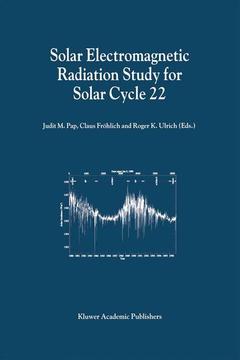Description
Solar Electromagnetic Radiation Study for Solar Cycle 22, Softcover reprint of the original 1st ed. 1998
Proceedings of the SOLERS22 Workshop held at the National Solar Observatory, Sacramento Peak, Sunspot, New Mexico, U.S.A., June 17–21, 1996
Coordinators: Pap Judit M., Fröhlich Claus, Ulrich Roger K.
Language: English
Subjects for Solar Electromagnetic Radiation Study for Solar Cycle 22:
Keywords
Corona; Orbit; Scale; Solar flare; Solar wind; Sun; Sunspot; Wind; solar
Solar Electromagnetic Radiation Study for Solar Cycle 22
Publication date: 10-2012
517 p. · 16x24 cm · Paperback
Publication date: 10-2012
517 p. · 16x24 cm · Paperback
Solar Electromagnetic Radiation Study for Solar Cycle 22
Publication date: 03-1998
517 p. · 17x24.4 cm · Hardback
Publication date: 03-1998
517 p. · 17x24.4 cm · Hardback
Description
/li>Contents
/li>
Measurements of solar irradiance, both bolometric and at various wavelengths, over the last two decades have established conclusively that the solar energy flux varies on a wide range of time scales, from minutes to the 11-year solar cycle. The major question is how the solar variability influences the terrestrial climate.
The Solar Electromagnetic Radiation Study for Solar Cycle 22 (SOLERS22) is an international research program operating under the auspices of the Solar-Terrestrial Energy Program (STEP) Working Group 1: `The Sun as a Source of Energy and Disturbances'. STEP is sponsored by the Scientific Committee of Solar-Terrestrial Physics (SCOSTEP) of the International Council of Scientific Unions (ICSU).
The main goal of the SOLERS22 1996 Workshop was to bring the international research community together to review the most recent results obtained from observations, theoretical interpretation, empirical and physical models of the variations in the solar energy flux and their possible impact on climate studies. These questions are essential for researchers and graduate students in solar-terrestrial physics.
The Solar Electromagnetic Radiation Study for Solar Cycle 22 (SOLERS22) is an international research program operating under the auspices of the Solar-Terrestrial Energy Program (STEP) Working Group 1: `The Sun as a Source of Energy and Disturbances'. STEP is sponsored by the Scientific Committee of Solar-Terrestrial Physics (SCOSTEP) of the International Council of Scientific Unions (ICSU).
The main goal of the SOLERS22 1996 Workshop was to bring the international research community together to review the most recent results obtained from observations, theoretical interpretation, empirical and physical models of the variations in the solar energy flux and their possible impact on climate studies. These questions are essential for researchers and graduate students in solar-terrestrial physics.
Preface. The Prototype RIS-PSPT Instrument Operating in Rome; I. Ermolli, et al. Solar Total Irradiance: A Reference Value for Solar Minimum; A.T. Mecherikunnel. New Measurements of the Solar Disk-Center Spectral Intensity in the Near IR from 645 nm to 1070 nm; K.A. Burlov-Vasiljev, et al. The Visible Solar Spectral Irradiance from 350 to 850 nm as Measured by the SOLSPEC Spectrometer During the Atlas I Mission; G. Thuillier, et al. GOME Solar UV/VIS Irradiance Measurements between 1995 and 1997 - First Results on Proxy Solar Activity Studies; M. Weber, et al. Solar Cycle 22 UV Spectral Irradiance Variability: Current Measurements by SUSIM UARS; L.E. Floyd, et al. Effect of Spectral Resolution on the Mg II Index as a Measure of Solar Variability; O.R. White, et al. Solar UV Activity at Solar Cycle 21 and 22 Minimum from NOAA-9 SBUV/2 Data; M.T. Deland, R.P. Cebula. Comparisons of the NOAA-11 SBUV/2, UARS SOLSTICE, and UARS SUSIM Mg II Solar Activity Proxy Indexes; R.P. Cebula, M.T. Deland. Solar Extreme Ultraviolet Irradiance Measurements During Solar Cycle 22; T.N. Woods, et al. EUV97: Improvements to EUV Irradiance Measurements During Solar Cycle 22; W.K. Tobiska, F.G. Eparvier. First Solar EUV Irradiances Obtained from SOHO by the CELIAS/SEM; D.L. Judge, et al. Solar Flux and Spectrum Measurements in the EUV Spectral Region on Board Coronas-I Satellite; T.V. Kazachevskaya, et al. Spatial Distribution of Sources of EUV Emission: Correlation of EUV and Microwave Emission with Ca II K Plage; W.M. Neupert. Solar Radiation Fluxes in the 10-30 nm Range from Studying the E-Region and E-F Valley; A.A. Nusinov, et al. Use of Simultaneous EUV and Soft X-Ray Measurements for Diagnostics of the Solar Flare Radiation Danger; L.A. Antonova, A.A. Nusinov.Pioneer Venus Orbiter Measurements of Solar EUV Flux During Solar Cycles 21 and 22; K.K. Mahajan, et al. Variations of Solar Irradiance, 10.7 cm Radio Flux, He I 10830 Å Equivalent Width and Global Magnetic Field Intensity and Their Relation to Large-Scale Solar Magnetic Field Structure; E.V. Ivanov, et al. Modeling Solar UV Variations Using Mount Wilson Observatory Indices; D.G. Parker, et al. Two Unusual Episodes of ≈ 13-Day Variations; P.C. Crane. Plage and Enhanced Network Indices Derived from Ca II K Spectroheliograms; J.R. Worden, et al. A 1-Year Set of Ca I K-line Filtergrams; A. Johannesson, et al. On the Intensity Thresholds of the Network and Plage Regions; M. Steinegger, et al. On the Determination of the Quiet-Sun Center-to-Limb Variation in CA II K Spectroheliograms; P.N. Brandt, M. Steinegger. Variations of the Chromospheric Network with the Solar Cycle; B. Caccin, et al. The Green Corona Index and Soft X-Ray Flux; M. Rybanský, et al. A Correlative Study of Green Coronal Intensity with Other Solar Indices; K.B. Ramesh. The Correlation between the CALERN Solar Diameter Measurements and the Solar Irradiance; J.P. Rozelot. Role of Time-Delay Concept in Understanding Mechanism of Total Solar Irradiance Variation and its Effect on the Climate of the Earth; H. Yoshimura. Modulation of Atmospheric 14C Concentration by the Solar Wind and Irradiance Components of the Hale and SCHWABE Solar Cycles; A.N. Peristykh, P.E. Damon. Prominences and the Green Corona over the Solar Activity Cycle; M. Minarovjech, et al. Ultra-High Resolution Nitrate in Polar Ice as Indicator of Past Solar Activity; G. Dreschhoff, E.J. Zeller.
© 2024 LAVOISIER S.A.S.
These books may interest you

Earth-affecting Solar Transients 105.49 €



